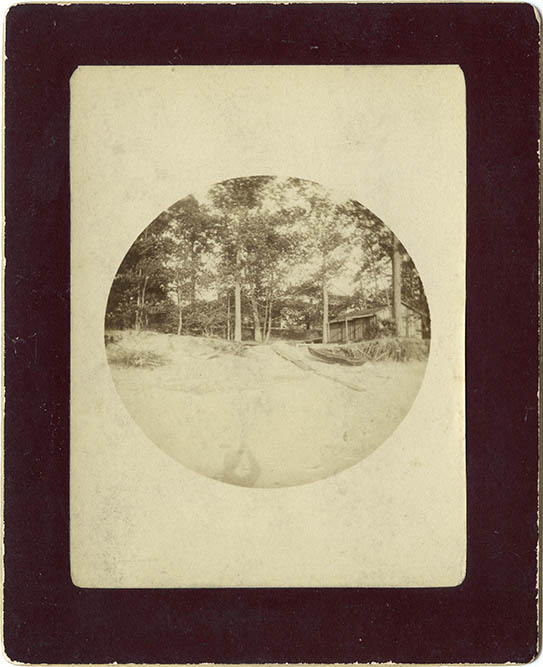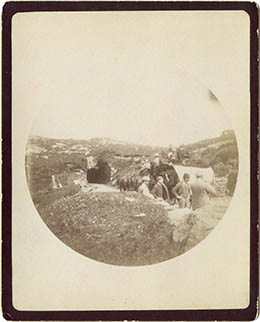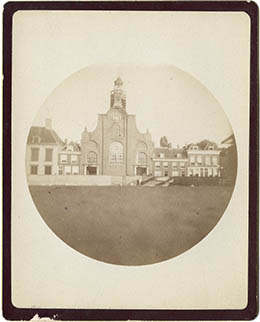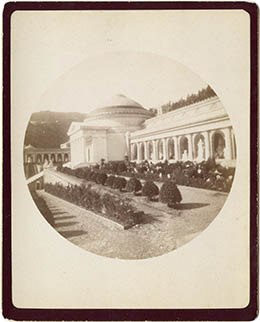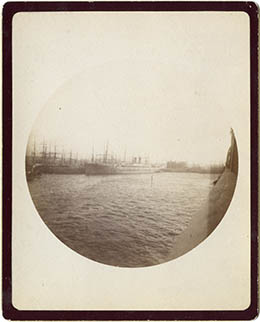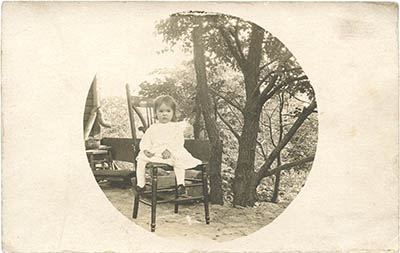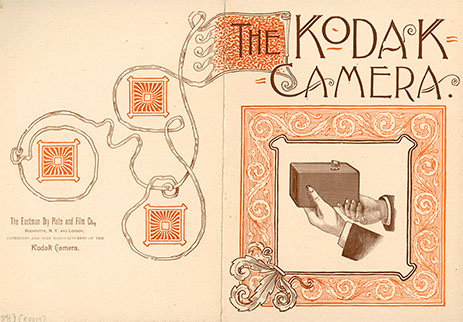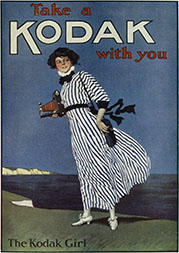61
Kodak
George Eastman and Popular Photography
This image of a bungalow on the beach, ca.1888, is not likely to win any awards for composition, but on the other hand is, honestly, not that bad for an amateur photo. The photo, a 2⅚" diameter albumen print mounted on a heavy card, was taken with the original Kodak camera and processed by the Eastman Company in Rochester, New York. It was one of the first snapshots.
George Eastman (July 12, 1854 – March 14, 1932) was the youngest of three children. His father died when he was eight and at 14 he left school to help support the family; first as an office boy, then as a bookkeeper for the Rochester Savings Bank. His interest in photography began when he planned a trip to Santo Domingo and bought a complete wet-plate photography outfit to record it. The trip was cancelled but Eastman soon became obsessed with photography.
He began experimenting with gelatin emulsions in his mothers kitchen at night and three years later had perfected a dry plate formula.1 This was soon followed by a machine to prepare them. With his formula and machine, Eastman, with his partner, Henry A. Strong, a buggy-whip manufacturer, formed the Eastman Dry Plate Company and became one of the first to successfully manufacture and sell dry plates; by November 1881 the company was making 4000 dry plates a month.
Of course if Eastman could mass-produce dry plates so could others and soon the market was flooded with prepared dry plates from dozens of manufacturers. So Eastman experimented with replacing the expensive glass plate with a cheaper backing and by 1884 had developed an emulsion on the cheapest possible material – paper. He had created photographic film.2
Eastmans’ film, which, among other issues, left the paper grain in the final image, was not particularly successful. Eastman then created a film where the developed image was stripped from the paper onto a flexible cellulose film – the so-called stripping negative.3
Even with his new cellulose film, however, there was still limited demand. He later said: “When we started out with our scheme of film photography, we expected that everybody who used glass plates would take up films. But we found that the number which did so was relatively small. In order to make a large business we would have to reach the general public.”
Kodak no. 2 prints
Kodak no. 2 postcard
Eastmans’ idea to “reach the general public” was to design an easy-to-use amateur camera, the Kodak, introduced in 1888. The Kodak, a simple box camera with a string-operated cylindrical shutter and a 57mm f/9 Rapid Rectilinear wide angle lens came preloaded with 20' of paper roll film (enough for 100 exposures). When the roll was exposed the entire camera was sent to Rochester, where the film was developed and printed and the camera was reloaded with film.4
Kodak advertisement, 1888 5
The Kodak marked a watershed in photography. No longer was it the provence of studio professionals, now anyone (with USD 25 for the camera and USD 10 for developing) could take photos. It was the beginning of popular photography and the snapshot.
The original model was soon replaced by the Kodak no. 1 (yes, the second Kodak was no. 1) which, among other things, upgraded the shutter, then the no. 2 (with larger 3.5" diameter negatives). By 1892 Eastman was advertising 14 different models, and over the next century they marketed hundred of cameras. All of these, of course, were ultimately designed to sell Kodak film.
1. The dry-plate process, AKA the gelatin process, was invented by the British photographer Richard Leach Maddox in 1871. The process consisted of dissolving silver nitrate and potassium bromide in a gelatin solution. This light-sensitive emulsion was then poured over a glass plate, typically using a glass rod to spread it evenly, and allowed to dry. Properly prepared plates could remain sensitive for months.
2. Eastman, George. "Photographic Film." US patent 306.594. 14 Oct 1884.
3. Eastman, George, Walker, William. "Photographic Film" US patent 306,470. 14 Oct 1884.
4. Eastman, George. "Camera." US patent 388.850. 4 Sep 1888.
5. From Duke University Library’s massive and wonderful Emergence of Advertising in America: 1850–1920 digital collection. To suggest that Eastman was a proponent of advertising is something of an understatement. He had an innate sense of effective advertising and promotion, including everything from slogans (“You push the button – we do the rest”) to full fledged campaigns, including the classic Kodak Girl, created in 1892. Here's an Australian Kodak Girl from 1911:
Eastman was one of the first major industrialists to fully embrace advertising, considering it just as important as manufacturing and research. He backed this up with unheard of resources: by the turn of the century he was spending USD 750,000/year for advertising.
16 Mar 2010, updated 8 Oct 2011 ‧ Photography
